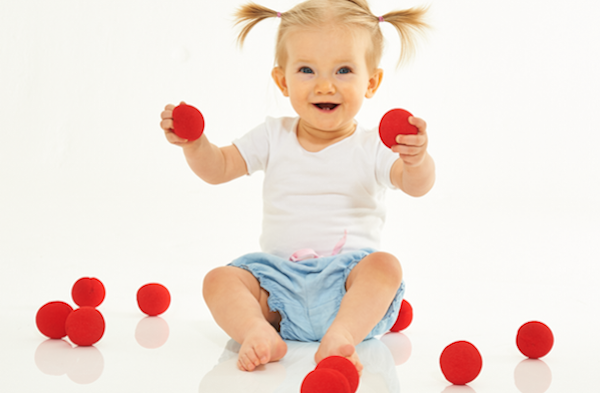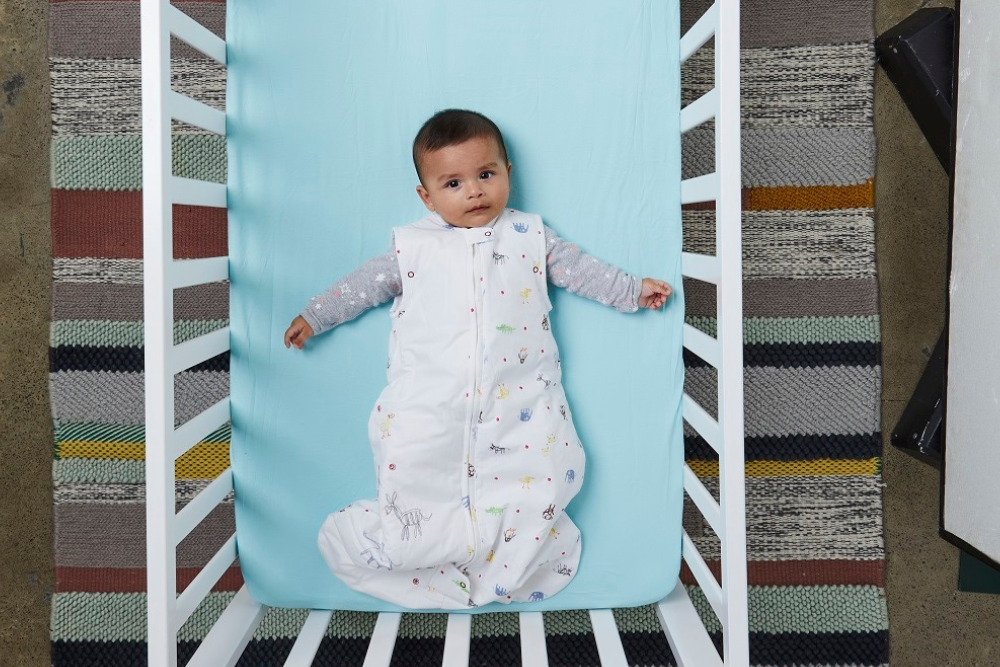Sarah Neale, Clinical Nurse Coordinator, The Mater Private Hospital
Newborns sleep up to a total of 16 hours per day, as sleep plays a crucial role in their growth and cognitive development. During sleep, their bodies undergo essential processes such as tissue growth, muscle development, and brain maturation. Quality sleep supports memory formation, sensory processing, and emotional regulation, laying the foundation for learning and healthy development as they grow. With so much time spent sleeping, it is incredibly important for parents to play a key role in creating a safe sleeping environment for their babies. Establishing good sleep habits early not only promotes healthy development but also helps ensure a restful night for both baby and parents.
Below are essential safe sleeping tips and practices every parent and mum-to-be should follow to reduce risks and promote a secure sleep space for their baby.
1. Sleep Baby on Their Back
The safest sleeping position for babies, from newborn to twelve months, is to place them on their back. Research has shown that this significantly reduces the risk of sudden unexpected death in infancy (SUDI), including sudden infant death syndrome (SIDS). Placing babies on their back minimizes the risk of suffocation and allows for better breathing.
When babies are old enough to roll over (typically around 4-6 months), they may naturally find their preferred sleeping position. However, parents should continue placing them on their back initially. If the baby rolls onto their stomach or side during sleep, there is no need to reposition them constantly, but always start them off on their back.
2. Ensure Baby’s Head and Face Are Fully Uncovered
At all times, a baby’s head and face should be completely exposed while sleeping. Covering the head can lead to overheating and increase the risk of suffocation. Ensure all bed sheets are tucked tightly and remove any loose items such as pillows, thick blankets, cot bumpers, and plush toys. These items pose a suffocation hazard and should be avoided entirely.
To keep your baby warm during colder months, opt for a safe infant sleeping bag that has a fitted neck, armholes, and no hood. Sleeping bags prevent babies from wriggling under blankets while maintaining a consistent temperature.
3. Dress Baby Appropriately for Room Temperature
Babies should be dressed in clothing suitable for the room temperature. A good rule of thumb is to dress them similarly to how you would dress yourself—comfortably warm but not overly hot. Overheating has been linked to an increased risk of SIDS, so it’s important to avoid overdressing your baby or using heated blankets.
To check if your baby is at a comfortable temperature, feel their back or tummy—it should be warm but not sweaty. Don’t be concerned if their hands and feet feel cool; this is normal and not an indicator of being too cold.
4. Create a Smoke-Free Baby Zone
Second-hand smoke exposure has been linked to an increased risk of SIDS and other respiratory complications. According to studies, infants exposed to second-hand smoke are up to three times more likely to die from SIDS than those in smoke-free environments. Additionally, passive smoke exposure can lead to respiratory infections, asthma, and impaired lung development in young children.
To protect your baby, establish a strict smoke-free environment in your home, nursery, car, and any space where your baby spends time. Even smoke residue on clothing, furniture, and walls—known as third-hand smoke—can be harmful to infants.
If you or someone in your household smokes, it’s crucial to take steps toward quitting. Speak with your GP or call Quitline on 137 848 for assistance and support in creating a healthier home environment for your baby.
5. Have a Separate Baby Sleeping Space in the Bedroom
While bed-sharing is common in some cultures and may feel comforting, babies require a different sleeping environment from adults. The safest option is to place a cot or bassinet in your bedroom, allowing the baby to be nearby but in their own separate sleeping space. This helps facilitate nighttime feeding while reducing the risk of accidental suffocation or overheating associated with bed-sharing.
6. Check Your Baby’s Cot Meets Australian Safety Standards
Whether purchasing a new cot or using a second-hand one, it must meet the latest Australian safety standards (AS/NZS 2172). This ensures that the cot has been designed with safety features that minimize risks such as entrapment, lead-based paints, and unstable structures.
Avoid using hand-me-down or older cots that do not have clear safety certification labels. If you are unsure whether your cot meets safety requirements, refer to the Australian Competition & Consumer Commission’s Product Safety Laws for household cots
7. Check Mattress Is Firm, Level, and Fits Cot Properly
Unlike adult beds or soft cushions, babies require a firm, flat mattress to sleep safely. The mattress should fit snugly in the cot without any gaps along the edges, as gaps can pose a risk of entrapment. Avoid adding extra padding or soft bedding, as these can increase the likelihood of suffocation.
To ensure the firmness of your baby’s mattress, refer to Standard AS/NZS 8811.1:2013 which outlines testing guidelines for infant mattresses. A firm mattress provides the necessary support and reduces the risk of accidental rolling and suffocation.
8. Breastfeed Baby If Possible
Breastfeeding provides numerous health benefits, including boosting immunity and reducing the risk of infections. Scientific research have also shown that breastfeeding lowers the risk of SUDI. However, not all parents are able to breastfeed, and it’s important to acknowledge alternative feeding options. Infant formula is a safe and nutritionally balanced option designed to support healthy growth and development. For parents who need additional support, consulting a healthcare provider or lactation consultant can help determine the best feeding method for their baby. Regardless of feeding choice, ensuring safe sleep practices remains the key to reducing sleep-related risks. provides numerous health benefits, including boosting immunity and reducing the risk of infections. Studies have also shown that breastfeeding lowers the risk of SUDI. While breastfeeding is not always possible for all parents, ensuring safe sleep practices is the key to reducing sleep-related risks, regardless of feeding method.
9. Inform Others Who Are Looking After Your Baby
If family members, babysitters, or caregivers are looking after your baby, ensure they are well-informed about safe sleeping practices. Not everyone may be familiar with the latest guidelines, so take a moment to explain your baby’s sleeping arrangements, including the importance of placing them on their back, keeping their face uncovered, and maintaining a smoke-free environment.
To make it easier for caregivers to follow these guidelines, consider providing a simple checklist covering key points such as:
-
Always place the baby on their back to sleep.
-
Keep the crib free of pillows, blankets, and stuffed toys.
-
Use a firm mattress with a well-fitted sheet.
-
Dress the baby appropriately for the room temperature to prevent overheating.
-
Ensure the baby sleeps in a separate, safe sleep space.
-
Maintain a smoke-free environment at all times.
Providing clear, written instructions or demonstrating safe sleep practices can help maintain a consistent and secure sleep environment for your little one. If family members, babysitters, or caregivers are looking after your baby, ensure they are informed about safe sleeping practices. Not everyone may be familiar with current guidelines, so take a moment to explain your baby’s sleeping arrangements and safety measures. Providing clear instructions can help maintain a consistent and secure sleep environment for your little one.
By following these safe sleeping practices, you are helping to create a secure and comfortable sleep environment for your baby. Safe sleep is essential for your baby’s health and well-being, and taking these extra precautions ensures peace of mind for parents. If you have any concerns about your baby’s sleep, consult with your healthcare provider for additional guidance.
Sarah Neale
Sarah Neale is a Clinical Nurse Coordinator at The Mater Hospital, one of Sydney’s leading maternity hospitals.
If you have any questions, your midwife or family doctor can guide you. The Mater Hospital, one of Sydney’s leading maternity hospitals, has a supportive and reliable team of midwives and professionals that are happy to listen to and attend to your needs.
https://www.matermaternity.com.au/
You may also like to read:
Tips to help new mums get more sleep
8 tips for surviving sleepless nights with a baby









